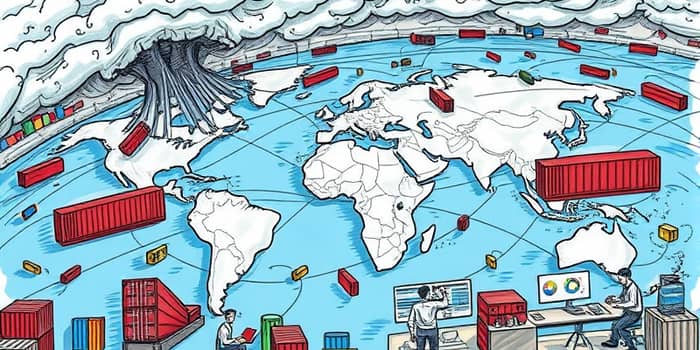
In 2025, businesses and communities around the world are grappling with the complex reality of deeply interwoven supply chains. From electronics factories to farms, lasting tremors from the pandemic have merged with rising geopolitical tensions, climate extremes, and evolving regulatory demands. The result is a challenging landscape where even minor glitches can cascade into widespread operational uncertainties and unanticipated costs.
Understanding the origins and ripple effects of these disruptions is essential. By examining the primary drivers, quantifying their impact on markets, and exploring practical resilience strategies, leaders can transform reactive management into proactive adaptation. This approach empowers companies to navigate current turbulence and emerge stronger over the long term.
Among the most pressing causes are the looming trade wars and proposed tariffs on imports from Canada, Mexico, and China. If enforced in 2025, these measures could unsettle over $30 billion in U.S. agricultural trade flows, driving up costs for producers and consumers alike.
Meanwhile, geopolitical conflicts—from persistent tensions between the U.S. and China to the ongoing war in Ukraine—have severed vital trade corridors. Multinational companies reliant on transcontinental shipping face sudden interruptions that delay deliveries and strain relationships with customers and partners.
Climate change compounds these pressures. Extreme weather events and natural disasters have become more frequent, interrupting logistics chains, damaging infrastructure, and threatening agricultural yields. Even well-prepared firms can find their carefully timed schedules upended by floods, wildfires, or record heatwaves.
Adding to this complexity are pandemic aftershocks that linger in labor markets and transportation systems. Labor shortages, evolving health protocols, and unpredictable consumer behaviors create a dynamic environment where long-term planning must account for sudden swings in capacity and demand. At the same time, stricter sustainability and traceability regulations—especially in food and manufacturing—require firms to overhaul sourcing strategies to meet new compliance thresholds.
Finally, the growing prevalence of cyberattacks on logistics and inventory management systems represents a silent but potent threat. A single breach can halt operations across multiple facilities, illustrating the need for robust digital defenses alongside physical safeguards.
The link between supply chain disturbances and inflation is well documented. In both the U.S. and Europe, these shocks have contributed at least 1.5 percentage points to recent inflation rates. According to the San Francisco Fed, as much as 60% of U.S. inflation over the last two years can be traced back to supply chain bottlenecks.
Without these disruptions, global trade volume from November 2020 to September 2021 would have been approximately 2.7% higher, with industrial production rising by 1.4%. In the U.S. specifically, the shortfall exceeded 4% for trade and 2% for output, underscoring the economic drag of interrupted flows of goods.
Stock markets have absorbed these shocks unevenly. Companies heavily reliant on imported components or raw materials have seen their share prices underperform, while higher producer costs often lead to profit warnings and increased market volatility. Tech and automotive sectors, in particular, have faced prolonged chip shortages and shipping backlogs that halt production lines and inflate consumer prices.
While quantitative measures highlight the magnitude of disruption, the human dimension is equally vital. Rising unemployment—driven by factory shutdowns or reduced hiring—can climb by 0.7 percentage points after major supply chain shocks. This displacement disproportionately affects vulnerable communities, deepening economic divides.
Essential goods such as medicine, energy, and food do not escape these pressures. Small farmers and independent grocers often lack the negotiating power to absorb sudden cost hikes, passing higher prices onto consumers who may already be struggling with rising living expenses.
The broader social consequences extend to global systemic risks. When resource scarcities sharpen inequalities between richer and poorer nations, tensions can escalate into unrest or conflict. In a hyperconnected world, instability in one region quickly spreads, reinforcing the need for holistic approaches that address both economic resilience and social equity.
To weather this era of continuous turbulence, organizations are embracing a range of adaptive measures. Investment in advanced analytics, real-time tracking, and automation is paramount, allowing firms to anticipate disruptions and reconfigure logistics on the fly.
These measures, however, require not just financial investment but also cultural transformation. Teams must be equipped with the skills to interpret complex data streams, collaborate across traditional silos, and maintain flexibility in the face of shifting priorities.
Experts increasingly agree that supply chain turbulence is a permanent feature of the business environment. The goal is no longer to eliminate every risk but to design networks that can absorb shocks and recover swiftly.
In embracing continuous adaptation, companies can turn disruption into an opportunity for transformation. By embedding resilience into every link of the chain, organizations protect their bottom lines, support their communities, and build a foundation for sustainable growth.
As you assess your own supply network, consider not only the direct cost implications but also the broader social and environmental stakes. Now is the moment to shift from reactive firefighting to proactive resilience, forging pathways that lead to greater agility, equity, and shared prosperity.
References













